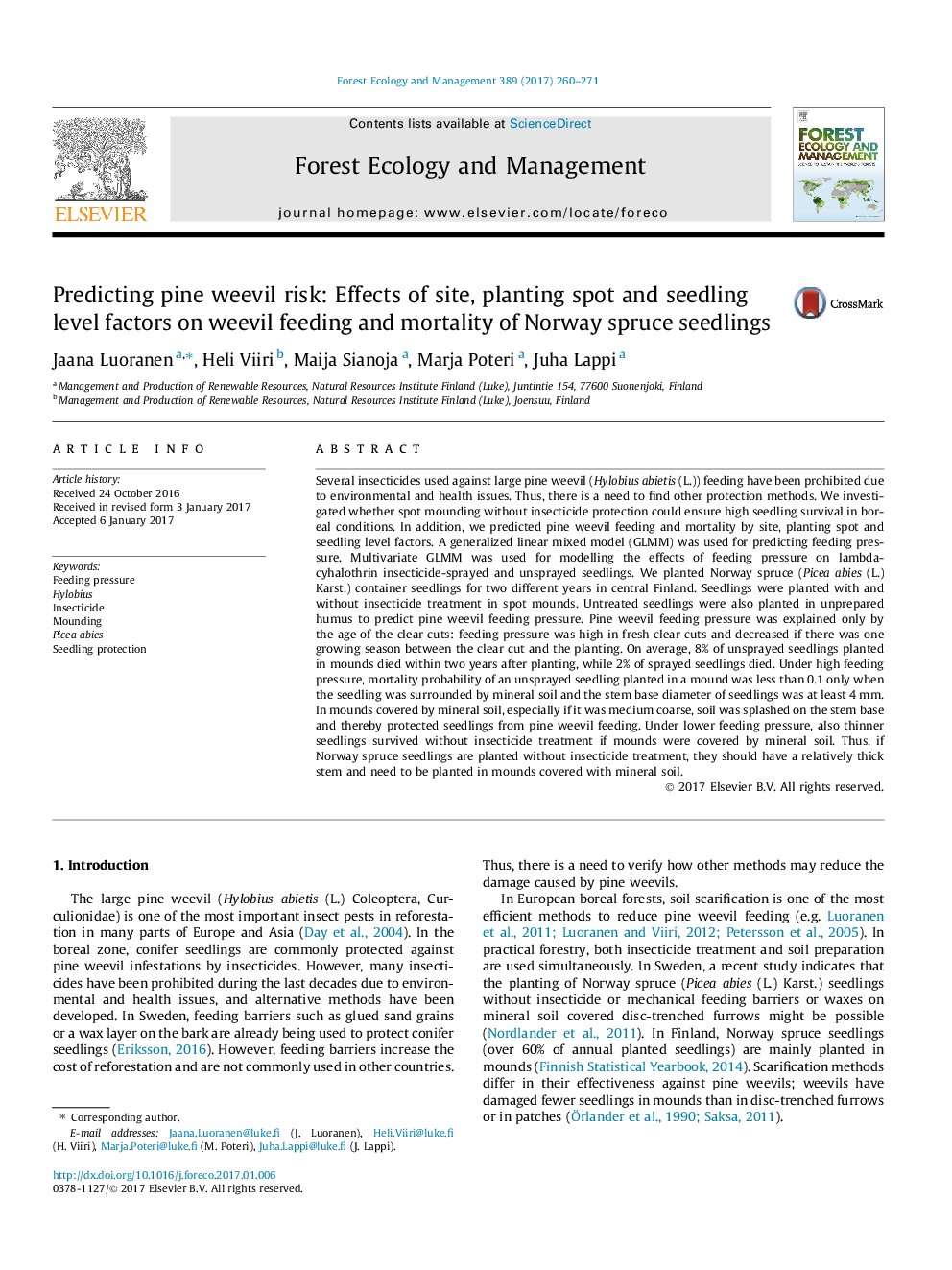| کد مقاله | کد نشریه | سال انتشار | مقاله انگلیسی | نسخه تمام متن |
|---|---|---|---|---|
| 4759508 | 1421369 | 2017 | 12 صفحه PDF | دانلود رایگان |
عنوان انگلیسی مقاله ISI
Predicting pine weevil risk: Effects of site, planting spot and seedling level factors on weevil feeding and mortality of Norway spruce seedlings
ترجمه فارسی عنوان
پیش بینی خطر علف های هرز کاج: تاثیر ساقه، فاکتور کاشت و فاکتور گیاهچه در تغذیه ناچیز و مرگ و میر نهال نعناع صنوبر
دانلود مقاله + سفارش ترجمه
دانلود مقاله ISI انگلیسی
رایگان برای ایرانیان
موضوعات مرتبط
علوم زیستی و بیوفناوری
علوم کشاورزی و بیولوژیک
بوم شناسی، تکامل، رفتار و سامانه شناسی
چکیده انگلیسی
Several insecticides used against large pine weevil (Hylobius abietis (L.)) feeding have been prohibited due to environmental and health issues. Thus, there is a need to find other protection methods. We investigated whether spot mounding without insecticide protection could ensure high seedling survival in boreal conditions. In addition, we predicted pine weevil feeding and mortality by site, planting spot and seedling level factors. A generalized linear mixed model (GLMM) was used for predicting feeding pressure. Multivariate GLMM was used for modelling the effects of feeding pressure on lambda-cyhalothrin insecticide-sprayed and unsprayed seedlings. We planted Norway spruce (Picea abies (L.) Karst.) container seedlings for two different years in central Finland. Seedlings were planted with and without insecticide treatment in spot mounds. Untreated seedlings were also planted in unprepared humus to predict pine weevil feeding pressure. Pine weevil feeding pressure was explained only by the age of the clear cuts: feeding pressure was high in fresh clear cuts and decreased if there was one growing season between the clear cut and the planting. On average, 8% of unsprayed seedlings planted in mounds died within two years after planting, while 2% of sprayed seedlings died. Under high feeding pressure, mortality probability of an unsprayed seedling planted in a mound was less than 0.1 only when the seedling was surrounded by mineral soil and the stem base diameter of seedlings was at least 4Â mm. In mounds covered by mineral soil, especially if it was medium coarse, soil was splashed on the stem base and thereby protected seedlings from pine weevil feeding. Under lower feeding pressure, also thinner seedlings survived without insecticide treatment if mounds were covered by mineral soil. Thus, if Norway spruce seedlings are planted without insecticide treatment, they should have a relatively thick stem and need to be planted in mounds covered with mineral soil.
ناشر
Database: Elsevier - ScienceDirect (ساینس دایرکت)
Journal: Forest Ecology and Management - Volume 389, 1 April 2017, Pages 260-271
Journal: Forest Ecology and Management - Volume 389, 1 April 2017, Pages 260-271
نویسندگان
Jaana Luoranen, Heli Viiri, Maija Sianoja, Marja Poteri, Juha Lappi,
